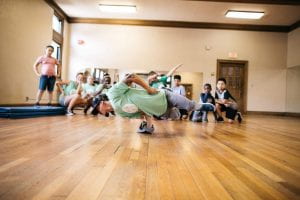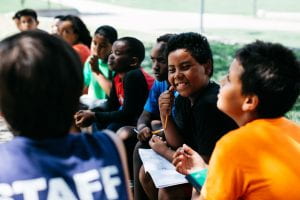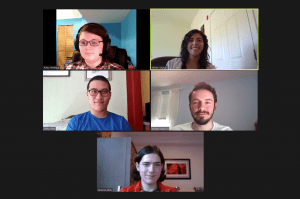Project Sponsor: Main IDEA
Main IDEA is a nonprofit Youth & Arts organization that offers free arts programming to youth ages 6-17 in Worcester, MA, with a priority given to residents of the Main South neighborhood. with a focus on empowerment and intrinsic motivation. These arts programs include not only visual art, but also music, dance, drama, and creative writing. Beginning as a volunteer project in 2011, Main IDEA has since developed into a 501(c)(3) nonprofit organization in 2015 and offers afterschool and summer arts programming throughout the year, serving 1,500 youth annually.
Student Researchers
From top left to bottom: Avery Vreeland, Miriam Sayegh, Jeffrey Mei, Achilles Gatsonis, and Nicholas Mills
Project Goal and Objectives
Goal
We assisted Main IDEA by determining the availability of accessible arts programs in Worcester and the impact of COVID-19 on programs to help improve the current state of art programming in Main South and demonstrated why this is an important community needs to fill.
Objectives
- We conducted an audit of accessible youth arts programming in Main South and Worcester.
- We assessed the need for more accessible youth arts programming in Main South and Worcester.
- We assessed the impact of COVID-19 on the accessibility of youth arts programming and the availability of funding for nonprofit organizations to meet this need.
- We made recommendations to Main IDEA on expanding the accessibility of youth arts programming in Main South during and following COVID-19 social distancing measures.
EXECUTIVE SUMMARY
Why The Arts Matter
Arts education and programming are essential tools in improving life outcomes for youth, particularly those at risk from factors such as childhood poverty, living in  areas with high crime rates, and childhood abuse (Coholic, 2011). But even without such risk factors, exposure to the arts can provide a number of key benefits to children and teens in the areas of emotional management, academic achievement, and prosocial behavior.
areas with high crime rates, and childhood abuse (Coholic, 2011). But even without such risk factors, exposure to the arts can provide a number of key benefits to children and teens in the areas of emotional management, academic achievement, and prosocial behavior.
In terms of emotional management, arts exposure helps youth improve their ability to resist peer pressure, and promotes self-respect and youth self-concept while also supporting the treatment of mental health problems, such as Post Traumatic Stress Disorder (Brunson et al., 2002; Lyshak-Stelzer et al., 2007; Coholic & Eys, 2015). Arts education also has a strong positive correlation with academic achievement, promoting early developmental skills with crafts, and continuing into traditional schooling, supporting high educational attachment, grades, and the development of key soft skills such as critical analysis (Hwang Lynch, n.d.; Catterall et al., 2012; Elpus, n.d; Kisida et al. 2015). Besides improving the emotional and educational outcomes of youth, arts education correlates with the development of prosocial views and behaviors, such as increased participation in student government and volunteering, and decreased drug use (Catterall et al., 2012; Elpus, n.d).
Worcester and Main South by the Numbers
The population of Worcester and Massachusetts are over 180,00 0 and 6.8 million, respectively. 75% of the Massachusetts population is white. The population of Main South is 13,000, and the non-White population percentage is up to 40%, reflecting Worcester’s increased non-White population percentage of about 50% (American Community Survey, Census Reporter). In terms of income, Main South households have a median income of $30,000, less than the median income of Massachusetts households at $70,000. A higher percentage of households in Main South have an income below the poverty line at 33%, compared to Worcester’s at 18% and Massachusetts at 10% (American Community Survey, 2018).
0 and 6.8 million, respectively. 75% of the Massachusetts population is white. The population of Main South is 13,000, and the non-White population percentage is up to 40%, reflecting Worcester’s increased non-White population percentage of about 50% (American Community Survey, Census Reporter). In terms of income, Main South households have a median income of $30,000, less than the median income of Massachusetts households at $70,000. A higher percentage of households in Main South have an income below the poverty line at 33%, compared to Worcester’s at 18% and Massachusetts at 10% (American Community Survey, 2018).
In Main South, Worcester and Massachusetts, youth aged 18 and under make up 24.2% of the population. Among students in Main South, 63% are Hispanic. This differs from the student population in Worcester which is 43%. In Main South schools, 91% of the students are considered high need and 67% are considered economically disadvantaged. While in the broader Worcester Public School District, 79% of students are considered to be high need and 58% are economically disadvantaged. In contrast, in Massachusetts overall, 48% of students are considered to be high need and 31% are economically disadvantaged. In Main South, 44% of students are ESL students, compared to 33% in Worcester overall and 11% in Massachusetts. In terms of MCAS scores, Main South has a lower percentage of students who fully met or exceeded state expectations compared to Worcester district and Massachusetts students (Massachusetts Department of Elementary and Secondary Education, 2019).
What Makes a Good Arts Program
To maximize positive outcomes for youth, it is important for art programs to follow managerial guidelines that ensure a meaningful, educational experience. It also must be both appealing and accessible to its clients.
Managerial Guidelines
- The program’s classes should be taught by professional artists
- The organization should provide professional presentations for the participants
- Participants should be involved in program management through fundraising or lobbying
Client Appeal
- The organization should offer a variety of programming
- They should not only focus on visual art, but also subjects like dancing and singing
- The offerings should be age-appropriate
- Participants should be given a voice in what projects they get to work on
- They should also be allowed to participate in group work
- Parents should be involved in the program
Client Accessibility
- The organization should be low cost or free
- The organization should accommodate transportation
- The program should occur in a safe environment
- The organization should provide translated documents
The Arts in Worcester Schools
The Massachusetts Department of Education (DOE) revised the Arts Framework to ensure a more well-rounded arts curriculum in 2019 that addresses creativity, presentation and performance, response, connection. The new curriculum includes a new media discipline, as well as the previous disciplines of dance, music, theatre, and visual arts. In Main South, elementary and middle schools students take visual art and music courses weekly. Additionally, various after school programs such as art club, band and chorus are also available. Although Main South schools like to address the arts, Main South high school students are only required to take one art class to graduate. While the Massachusetts DOE’s revisions are significant, core subject areas such as Math, English, and Science, will always be the primary focus of schools, in which arts organizations will have to fill the gap on Main South’s need for arts education.
About Our Project
Our goal for this project is to assist our Sponsor Main IDEA, a youth arts program located in the Main South neighborhood of Worcester that focuses on Main South. in understanding the lack of youth arts programming and the impact of COVID-19 on accessibility of said programming. We made recommendations to Main IDEA based on our research.
Our research was conducted by distributing surveys to youth arts organizations and guardians of youth in Worcester, conducting interviews with program directors, and researching youth arts programs in Worcester. It is important to note, that due to the COVID19 pandemic, our research was conducted entirely online. We faced difficulties in reaching the parent/guardian populations and had a relatively small sample of youth organizations. Despite these challenges, we believe our limited results will be helpful in assisting youth organizations with planning in the future.
Key Findings
For the current accessibility of youth organizations in Worcester and Main South, we found that 13 out of 14 of surveyed youth organizations state they serve underserved youth. Over half of these organizations, however, do not specify their methods nor define underserved. The five organizations in Main South state they serve underserved participants and record their geographic residences. We found that the important factors for accessibility of youth arts programs in Worcester are: the monetary cost, transportation, and document translation to multiple languages. According to another survey we distributed, most parents/guardians want to pay less than $50 per week per child and are willing to drive up to 10 miles.
Due to COVID-19, youth organizations in Worcester have seen a 21% reduction in staff capacity, cut the quantity of programming or are offering their programs less frequently, seen decreased revenue, implemented virtual programming, and plan to have in-person programming resume by Fall 2020 according to a survey we distributed. COVID-19 has also impacted the families of participants. Most youth organizations in Worcester plan to continue virtual programming after Phase 4 of the Massachusetts reopening according to the same survey. However, about ¼ of Main South households with children do not have regular internet access or a computer (American Community Survey, 2018). Families may also be more concerned with securing housing or food and are therefore not willing to access public hotspots for their children to access virtual programming.
Recommendations
Given the limited programming available and the need for more in Main South, we have developed several recommendations for Main IDEA. First, we recommend continuing to expand programming in Main South; according to a survey we distributed, most parents/guardians agreed that Main South would benefit from additional accessible youth arts programs. Second, p roviding participants in need with free mobile hotspots to allow them to access virtual programming since many households in Worcester do not have regular internet access or a computer (American Community Survey, 2018). Third, monitoring and possibly expanding programming to areas outside of Main South, such as Vernon Hill, would help support other underserved areas. Fourth, continuing to develop and maintain a diverse staff which is similar to Main South’s demographics would help to build community between the Main IDEA staff and volunteers and the student participants. Last, we recommend that Main IDEA work with another IQP team to expand on our research, conduct a more thorough investigation of parent/guardians, and to identify additional underserved areas for potential expansion.
roviding participants in need with free mobile hotspots to allow them to access virtual programming since many households in Worcester do not have regular internet access or a computer (American Community Survey, 2018). Third, monitoring and possibly expanding programming to areas outside of Main South, such as Vernon Hill, would help support other underserved areas. Fourth, continuing to develop and maintain a diverse staff which is similar to Main South’s demographics would help to build community between the Main IDEA staff and volunteers and the student participants. Last, we recommend that Main IDEA work with another IQP team to expand on our research, conduct a more thorough investigation of parent/guardians, and to identify additional underserved areas for potential expansion.
Conclusions
Youth arts programs help youth with emotional management skills, encourage academic success, and promote prosocial views and behaviors. However, the arts programming in Worcester Public Schools may not be enough, which leaves other organizations to offer more youth arts programs. We found that there is limited programming available in Main South and there is a need for more. COVID-19 has caused youth arts organizations in Worcester to reduce the variety of offerings, lowered revenue and staff capacity, move to virtual programming, and led to a decrease in youth served. However, many of Main South households with children do not have regular internet access or a computer (American Community Survey, 2018) which may prevent youth in these households from being able to participate in youth arts programs. This issue may continue past phase four reopening, since most organizations we surveyed plan to continue virtual programming after the end of most social distancing restrictions. We hope the results of our study will provide Main IDEA with the information needed to address the impact of COVID-19 and to continue serving the community of Main South and Worcester.
 Loading…
Loading…



